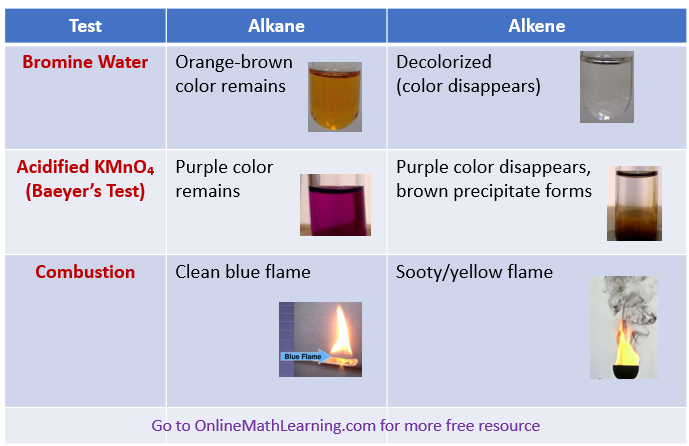Tests For Alkanes And Alkenes
Related Pages
Reactions of Alkanes
Reactions of Alkenes
More Lessons for IGCSE Chemistry
Chemistry Lessons
A series of free IGCSE Chemistry Activities and Experiments (Cambridge IGCSE Chemistry). This lesson looks at tests for alkanes and alkenes.
Alkanes (saturated hydrocarbons) and alkenes (unsaturated hydrocarbons with C=C bonds) can be identified using specific chemical tests.
This activity compares the reaction with bromine water of several liquid alkanes and alkenes. The test for unsaturation is demonstrated.
The activity can be extended to include testing the samples with a 1% potassium manganate(vii) solution. Small samples of the liquids are also ignited and the appearance of the flames compared.
The following table gives a summary of the tests for alkane and alkene: bromine test, Baeyer’s test, and combustion test. Scroll down the page for more examples and videos.

- Bromine Water Test
Testing Alkanes And Alkenes Using Bromine Water
How to distinguish between and alkene and alkane using bromine water.
Alkenes are unsaturated and decolourise an orange solution of bromine water. Alkanes are
saturated and do not react with bromine water, so the orange colour persists.
In the following experiment, the first test tube contained cyclohexene and the second test tube containes cyclohexane.
- Add 1-2 drops of bromine water (Br2 in H2O) to the hydrocarbon.
- Shake and observe:
Negative (Alkane): Stays orange.
Positive (Alkene): Orange → Colorless.
- Baeyer’s Test (Potassium Permanganate Test)
Alkenes react with KMnO4 (purple) turning the solution brown (MnO2 precipitate).
Alkanes do not react (purple remains).
- Add KMnO4 to the hydrocarbon.
- Observe:
Negative (Alkane): Purple persists.
Positive (Alkene): Purple → Brown precipitate.
Addition of bromine (bromine water) and potassium manganate (VII) KMnO4 to cyclohexene
In the following experiment, the cyclohexene decolourises the bromine water and changes the potassium manganate from purple to brown. There will be no colour change if cyclohexane is used instead of cyclohexene.
- Combustion Test (Flame Characteristics)
Alkanes burn with a cleaner/blue flame (complete combustion).
Alkenes burn with a sooty/yellow flame (higher C:H ratio, incomplete combustion).
Combustion of cyclohexane and cyclohexene
Flammability:
Place about 5 drops of the liquid in an evaporating basin.
Set the liquid on fire by placing a lighted taper or splint near it.
Note the colour and smokiness on the flame in each case.
In addition, note whether any carbon residue is left in the dish.
Observation:
Cyclohexane produces less colour intensity and less soot given off during combustion test compared
to cyclohexene.
Reason:
- Cyclohexane is a saturated hydrocarbon and cyclohexene is an unsaturated hydrocarbon due to the presence of double bond.
- Both hydrocarbons produce carbon dioxide and water during combustion test. When the oxygen is limited, the product will be carbon monoxide and water.
- Cyclohexene burns and produces more soot because of the higher percentage of carbon compared to cyclohexane.
Questions
- What difference was observed between the flames for alkanes and alkenes?
- What feature of the molecules gives rise to this difference?
-
Show Answers
- Alkanes produces less colour intensity and less soot given off during combustion test compared to alkenes.
- The alkenes have a higher proportion of carbon in their molecules - they have a higher C:H ratio.
Key Notes
- Bromine Water is the most reliable test for unsaturation.
- Baeyer’s Test is sensitive to other reducing agents (false positives possible).
- Combustion is qualitative; use with other tests for confirmation.
Try out our new and fun Fraction Concoction Game.
Add and subtract fractions to make exciting fraction concoctions following a recipe. There are four levels of difficulty: Easy, medium, hard and insane. Practice the basics of fraction addition and subtraction or challenge yourself with the insane level.

We welcome your feedback, comments and questions about this site or page. Please submit your feedback or enquiries via our Feedback page.